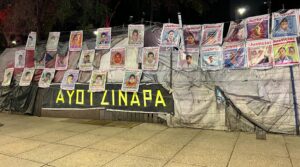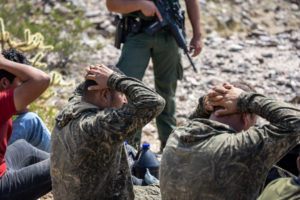By Maureen Meyer and Clay Boggs
More than 52,000 unaccompanied children have crossed into the United States since October 2013, and it is estimated that up to 90,000 may cross this year; over 39,000 of these children are from three countries in Central America: El Salvador, Guatemala, and Honduras. As with the increasing flows of overall migration from Central America, most of these children have entered through South Texas, overwhelming shelters and detention centers.
Much of the discussion has focused on why there has been a surge in migration from Central America, examining the Obama administration’s immigration enforcement policy as well as the root causes of migration, particularly violence and poverty in Central America. However, less attention has been paid to what happens to Central American migrants on their journey to the United States. Indeed, the notion that Central Americans are getting a “free pass” into the United States is much less credible when considering the tremendous risks and dangers that migrants face on their journey through Mexico.
Central Americans have crossed through Mexico for decades. In the 1980s, thousands fled civil wars. Some stayed in Mexico, but more continued on to the United States. Since then, Central Americans have continued to abandon their homes, fleeing poverty and violence. In recent years, as violence in Central America has escalated (Honduras is now the most violent country in the world) and the rule of law has continued to deteriorate, more and more people have made the difficult decision to make the trek northward.
Although migrants in transit have historically been abused by both criminal groups and Mexican authorities, the situation has worsened significantly in recent years, particularly as organized criminal groups operating in the regions through which migrants transit have viewed this population as easy prey for kidnapping, trafficking, extortion, and other crimes. A 2009 report by Mexico’s National Human Rights Commission (Comisión Nacional de los Derechos Humanos, CNDH) found that 10,000 migrants were kidnapped in a six-month period. A subsequent report by the Commission in 2011 documented over 11,000 kidnappings in another six-month period. The kidnapping of migrants often occurs en masse—as many as 400 migrants may be kidnapped together and held in a “safe house,” a term frequently used to describe the buildings where criminal groups hold the migrants.
Kidnapping continues to occur on a chilling scale. Migrant shelters have told WOLA that most kidnappings are orchestrated by organized criminal groups, and that human smugglers routinely turn migrants over to kidnappers once they reach northern Mexico. Mexican newspapers frequently publish stories about the “rescue” of migrants by authorities. The use of the term “rescue” is troubling as in many cases it is not clear whether the migrants were kidnapping victims or if they were simply detained by authorities while in transit, and because on many occasions, Mexican officials do not attend to these migrants as possible victims of crime. In the first six months of 2014, the press reported in the state of Tamaulipas (which borders south Texas) the following “rescues” of migrants from mass kidnappings:
- Federal authorities reported that between January 1, 2014 and February 21, 2014, they had “rescued” a total of 404 migrants in Tamaulipas.
- On March 31, 2014, the army “rescued” 75 migrants, including 17 Mexicans, from a safe house in Miguel Aleman, Tamaulipas.
- On April 13, 2014, the state police “rescued” 48 Central American migrants from a safe house in Matamoros, Tamaulipas.
- On April 20, 2014, the army “rescued” 60 migrants in Gustavo Diaz Ordaz, Tamaulipas.
- In late May 2014, 68 migrants were “rescued” in Reynosa, Tamaulipas.
These reports, of course, do not include those migrants who were not rescued. Nor do the news reports provide information about whether the victims, who may be eligible under Mexican law to receive humanitarian visas, were deported.
The Zetas and other criminal organizations are able to kidnap migrants on such a large scale because of widespread corruption in Mexico’s law enforcement and immigration enforcement agencies. Migrant shelters across Mexico have received testimonies from migrants describing widespread incidents of extortion, kidnapping, and other abuses committed by criminal groups with the participation or collusion of state agents, including federal, state, and local police officials, immigration officials of Mexico’s National Institute for Migration (Instituto Nacional de Migración, INM), and members of the Mexican military. In 2013 the CNDH received 454 complaints of human rights violations by INM officials. In 2010 and 2011, the corpses of 314 individuals, many of them migrants, were found in three mass graves located in San Fernando, Tamaulipas and Cadereyta, Nuevo León. Two hundred of them have yet to be identified, and there is evidence of collusion of the authorities, either directly or by omission, in the massacres in Tamaulipas.
Since 2006, thousands of individuals have disappeared in Mexico. Government officials have given wildly different figures for the how many have disappeared. A database from the Calderón administration indicated 26,000 disappeared; Secretary of the Interior Osorio Chong revised that figure in May 2014 to 8,000, but in June 2014 affirmed that there were 16,000 disappeared. Despite requests from the Mexican civil society organization Foundation for Justice and the Democratic Rule of Law (Fundación para la Justicia y el Estado Democratico de Derecho), officials have been unable to provide estimates of how many of these individuals were migrants from Central America or other countries.
As WOLA highlighted in a recent report, from January to October 2013 the staff at the migrant shelter in Saltillo, Coahuila (Casa del Migrante de Saltillo, Frontera con Justicia, A.C.) collected testimonies from Central American migrants who had suffered abuses during their journey through Mexico. Twenty of these testimonies involved migrants who were victims of abuse by Federal Police agents; eighteen of these cases involved extortion. The incidents occurred primarily during searches of buses at checkpoints on highways in different parts of the country; in many cases it appears that the migrants were specifically targeted by the Federal Police as they searched the vehicle. In at least eight of the cases, Federal Police threatened to turn the migrants over to the INM. In other cases, the police officers used force or the threat of force to compel migrants to pay them. Although in many cases the police asked for relatively small amounts (less than US$100), in others the migrants were forced to give them all of the money they had (often hundreds of dollars). The migrant house in Saltillo has also documented cases of torture by Saltillo’s Municipal Preventative Police (Policía Preventiva Municipal de Saltillo); in the first half of 2013, Saltillo’s staff documented 35 incidents of torture committed by this force.
The cases of extortion and torture registered by the Casa del Migrante in Saltillo reflect a trend that has been observed by other shelters and human rights organizations in Mexico. A November 2013 report by the Documentation Network of Organizations that Defend Migrants (Red de Documentación de las Organizaciones Defensoras de Migrantes) in collaboration with the Jesuit Migration Service analyzed 931 testimonies of migrants gathered by seven shelters in Mexico, in the first six months of 2013. Of these testimonies, 167 migrants reported suffering abuses at the hands of Mexican authorities. The Federal Police were responsible for the highest number of cases of abuse (59 cases, 35 percent of the total registered) with 31 of the incidents involving extortion and 16 involving theft.
Given the widespread and well-documented involvement of Mexican authorities with human smugglers and organized crime, increased immigration enforcement in Mexico is likely to accomplish little, and will only contribute to the further enrichment of corrupt officials and criminals, and to the victimization of innocent migrants, including children and families.
What, then, should U.S. policymakers do in response to the surge in Central American migration to the United States?
- Focus on root causes. Poverty and violence are not easy problems to solve, and the United States cannot expect to transform Central America overnight. But there are programs to reduce violence and provide employment that have been proven to work. By focusing assistance on migrant-sending communities and vulnerable populations, such as at-risk youth, the United States can help provide individuals with viable alternatives to migration. By spending a fraction of what it spends on border security, the U.S. government could make a significant difference in Central America and relieve the pressures that force people to leave their homes in search of a better, safer life.
- Target U.S. assistance to improve accountability in Mexico’s INM and the Federal Police. The INM and the Federal Police are the two agencies that are tasked with enforcing Mexico’s immigration laws. Until these agencies address endemic issues of corruption and abuse, these agents will continue to collude with human smugglers and organized crime. The United States currently provides assistance to both of these agencies through the Merida Initiative. Such assistance should be focused on strengthening internal and external controls and professionalization.
This commentary was updated on July 3, 2014 in order to clarify the section on the “rescue” of migrants by Mexican security forces.


